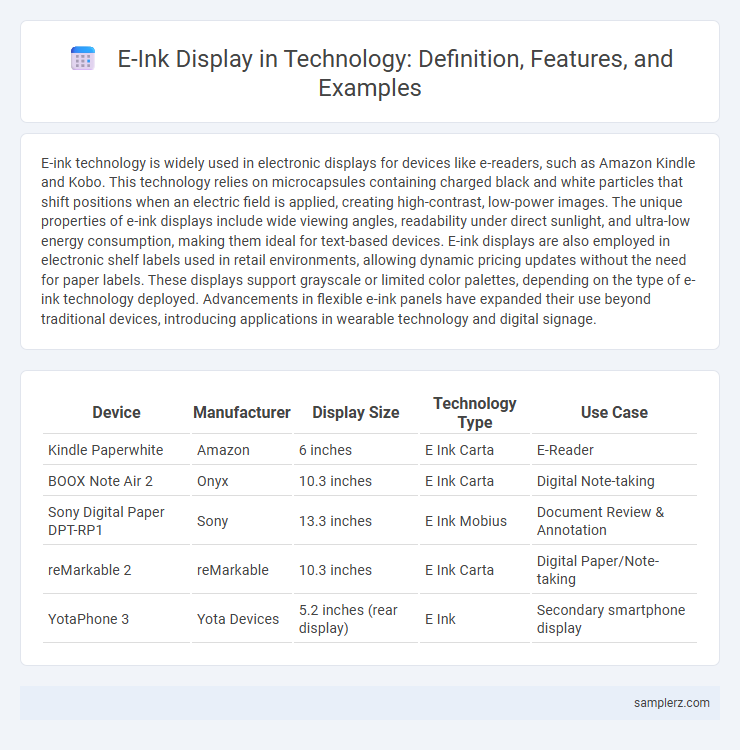E-ink technology is widely used in electronic displays for devices like e-readers, such as Amazon Kindle and Kobo. This technology relies on microcapsules containing charged black and white particles that shift positions when an electric field is applied, creating high-contrast, low-power images. The unique properties of e-ink displays include wide viewing angles, readability under direct sunlight, and ultra-low energy consumption, making them ideal for text-based devices. E-ink displays are also employed in electronic shelf labels used in retail environments, allowing dynamic pricing updates without the need for paper labels. These displays support grayscale or limited color palettes, depending on the type of e-ink technology deployed. Advancements in flexible e-ink panels have expanded their use beyond traditional devices, introducing applications in wearable technology and digital signage.
Table of Comparison
| Device | Manufacturer | Display Size | Technology Type | Use Case |
|---|---|---|---|---|
| Kindle Paperwhite | Amazon | 6 inches | E Ink Carta | E-Reader |
| BOOX Note Air 2 | Onyx | 10.3 inches | E Ink Carta | Digital Note-taking |
| Sony Digital Paper DPT-RP1 | Sony | 13.3 inches | E Ink Mobius | Document Review & Annotation |
| reMarkable 2 | reMarkable | 10.3 inches | E Ink Carta | Digital Paper/Note-taking |
| YotaPhone 3 | Yota Devices | 5.2 inches (rear display) | E Ink | Secondary smartphone display |
Introduction to E-Ink Technology in Displays
E-Ink technology revolutionizes digital displays by mimicking the appearance of ink on paper, offering low power consumption and excellent readability in direct sunlight. This electrophoretic display uses microcapsules containing charged pigment particles that move to display text and images, making it ideal for e-readers and smart labels. E-Ink screens provide a flicker-free, high-contrast viewing experience while significantly extending battery life compared to traditional LCD or OLED displays.
Key Features of E-Ink Displays
E-ink displays feature low power consumption, making them ideal for devices like e-readers by allowing weeks of battery life on a single charge. Their high contrast and readability in direct sunlight result from the electrophoretic technology that mimics ink on paper. These displays also support wide viewing angles and cause minimal eye strain, enhancing user comfort during extended reading sessions.
Popular E-Reader Devices Using E-Ink
Popular e-reader devices using e-ink technology include the Amazon Kindle Paperwhite, Kobo Clara HD, and Barnes & Noble Nook GlowLight. These devices utilize e-ink displays to provide a paper-like reading experience with low power consumption and high contrast, enhancing readability in various lighting conditions. E-ink screens are ideal for prolonged reading sessions due to their glare-free properties and excellent battery efficiency.
E-Ink Displays in Smartwatches
E-Ink displays in smartwatches offer exceptional battery efficiency by using minimal power to update the screen only when necessary, extending device lifespan significantly. These displays provide high readability under direct sunlight due to their reflective nature, making them ideal for outdoor use. Popular models like the Garmin Instinct Solar employ E-Ink technology to balance functionality and prolonged battery life effectively.
E-Ink in Digital Signage and Retail
E-Ink technology enhances digital signage and retail displays by offering high visibility in direct sunlight and ultra-low power consumption, making it ideal for dynamic price tags and informational signage. Retailers leverage E-Ink to update product details and promotions in real-time while reducing energy costs and waste from paper printouts. Its bistable nature allows displays to maintain images without power, significantly extending battery life for portable or remote digital signage solutions.
E-Ink Applications in Notebooks and Tablets
E-Ink technology is widely used in notebooks and tablets to enhance readability while minimizing eye strain, featuring low power consumption that extends battery life significantly. Devices like the reMarkable tablet and Onyx Boox series leverage E-Ink displays for note-taking, reading, and annotating documents with high contrast and sunlight visibility. This technology supports a digital paper-like experience, making it ideal for professionals and students who require both portability and extended usage without frequent charging.
E-Ink Integration in Smartphones
E-Ink integration in smartphones enhances battery efficiency by utilizing low-power display technology commonly found in e-readers like the Amazon Kindle. Models such as the Hisense A7 and YotaPhone feature secondary E-Ink screens that provide clear, readable interfaces for notifications, e-books, and outdoor visibility without draining battery life. This innovation merges traditional LCD or OLED displays with E-Ink, offering users extended screen time and improved eye comfort in various lighting conditions.
Innovative E-Ink Use in Smart Home Devices
E-ink technology is revolutionizing smart home devices by enabling energy-efficient, high-contrast displays for thermostats, security panels, and smart mirrors. These innovative uses of e-ink reduce power consumption while maintaining readability in various lighting conditions, enhancing user experience and device longevity. Leading brands like Amazon and Nest integrate e-ink displays to optimize functionality and sustainability in connected home ecosystems.
Advantages of E-Ink over Traditional Displays
E-ink displays consume significantly less power than traditional LCD or OLED screens, enabling longer battery life in devices such as e-readers. Their high visibility under direct sunlight and reduced eye strain make them ideal for prolonged reading sessions. Furthermore, e-ink technology offers a wider viewing angle and better readability in various lighting conditions compared to conventional display technologies.
Future Trends and Developments in E-Ink Displays
E-ink displays are evolving with advancements such as color e-ink technology, flexible substrates, and improved refresh rates, enabling broader applications from smartwatches to digital signage. Emerging trends include integration of low-power, high-resolution panels in wearable devices and foldable e-readers, enhancing user experience through longer battery life and durability. Future developments focus on dynamic color capabilities and improved scalability, positioning e-ink as a competitive alternative to traditional LCD and OLED screens in energy-efficient display markets.

example of e-ink in display Infographic
 samplerz.com
samplerz.com